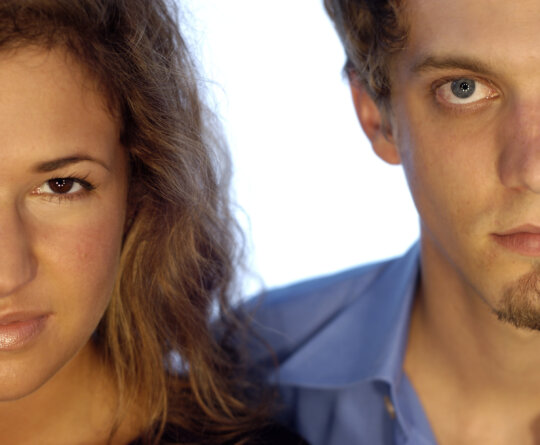







At this time of year, in 1996, I arrived to Berne. Perhaps the constellations bore similarity to their present alignment. I had a violin case on my back, a small suitcase in one hand, and a certain sense of excitement intermingled with apprehension as I stepped off the train that had brought me from Zurich airport. Walking out onto the main station square, I heard a lilting, song-like language around me. Bärndütsch. It would take me quite some time to understand the language, and the culture that came along with it. In the high German I had learned at school, I turned to a stranger and asked for directions to Berne’s “Konsi” - I was to meet my teacher Igor Ozim there for the start of semester. My first semester as a third-level student, my first time away from home, alone, for more than just some days.
I would study for more than four years with Igor, both at Konsi and at masterclasses.
We listened to stories about Igor’s teacher Max Rostal, and Rostal’s teacher Carl Flesch. Rostal had taught in Berne for two decades; and Ozim would follow suit.
The class came together once every two weeks for a group class to play for one another – scales, etudes, caprices, solo sonatas, whatever we had ready. Each piece was listened to with care and attention. A certain sense of camaraderie existed amongst us. I considered my class mates friends, a bunch of international, fun, vibrant people: Gabriel Adorjan, now concert master at the Deutsche Oper in Berlin. Ulrich Poschner, now first violin in Lucerne and concert master of the Argovia Philharmonic. Patricia Kopatchinskaja, treading the boards all over the world. Thomas Timm, principle second violin of the Berlin Philharmonic. Bettina Sartorius, second violin of the Berlin Philharmonic.
I began taking notes from my first lesson onwards. Igor loaded his classes with information and I felt the only way to keep track was to document the lessons. That trait was one I continued throughout my studies with all my teachers. I had the good fortune to be taught by a well-known representative of each of the five major violin schools. My parents Ronald Masin and Maria Kelemen. My first teacher outside of my family, Herman Krebbers, thereafter Igor Ozim, Zakhar Bron, Ana Chumachenco, Shmuel Ashkenasi. I played and wrote, documented and recorded, driven by a burning appetite for knowledge. I began teaching already before my studies with Igor Ozim, but in Berne, I continued, trying out their techniques and ideas, throwing in my own, learning by doing.
My friends in the class were outstanding, ambitious players. However, none of them enjoyed writing, and none of them taught.
Coming from a family of musicians and pedagogues, it was a natural step for me to jot down the tips I was being given. I spent hours in airports writing down what I was learning while waiting idly for flights.
My head was so full of information when I completed my third-level studies a decade later that I began to type everything out. It resulted in a PhD full of interviews with my former teachers, and a comparative study of the existing material on violin playing since the big bang of modern violin playing, since Viotti in 1750. I conducted interviews with my teachers, as well as ones with whom I studied intermittently: Nora Chastain, Thomas Brandis who led the Berlin Philharmonic for many years, Boris Kuschnir, Sigmund Niesel from the Amadeus Quartet, Gerhard Schulz from the Alban Berg Quartet. My curiosity about lineage – are we all connected to one another by six degrees of separation? – was one of my motivations.
Since my studies in Berne I have spent much of my life on the road performing. I have lived in Zurich, Florence, Lübeck, Hamburg, Berlin, Budapest, and Geneva, but I have returned to Berne throughout. I always kept a flat somewhere in the city and have never missed a summer swim in the Aare.

Sometimes, I’m asked "Why Berne? Why not a different place?”
There are many reasons, but one of them must be the waters of the Aare. The luxury of walking down nearly any street in the town with direct access to its clear, crisp waters is appreciated to the point where queues form around the banks of the river in summer as people patiently wait their turn to swim.
My final swim of summer 2022 took place last week, with my friend and duo partner Simon Bucher. Simon and I met for the first time in Berne’s Konsi in 1996. Ever since, the ritual of hurrying to the river on a bicycle, meeting Simon on a meandering street that stretches alongside the Aare, followed by jumping in and drifting down the river, offers a space of timelessness in a world of constant pace. The cold of the water against warm skin, rustling pebbles on the riverbed, the swish of whirlpools that form at intervals along the journey, the light and shadow that plays on the surface, a particular scent that the green water embodies as the season lingers in the air is an immersive experience like none other I know. It brings with it a sense of rebirth and entices a loud cry of joy at the shock of cold water every time I dive in. “Äs isch chalt! U so schampar schön!”, I inevitably call, in my best Bärndütsch, the sound of my voice echoing off the walls of a bridge the Aare flows under. Fire and Water, Earth and Air – the elements combined.